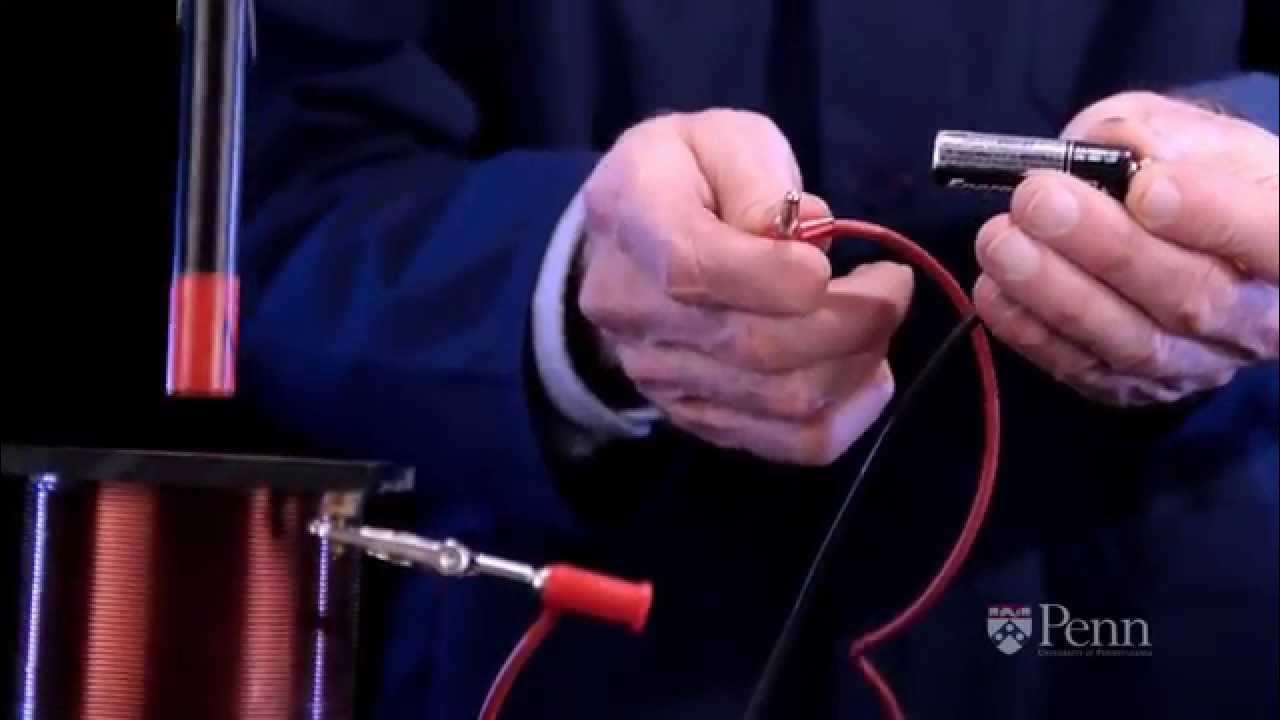Induksi Elektromagnetik (Fisika SMA/MA Sagufindo kls XII smt 1)
Summary
TLDRIn this engaging video on electromagnetic induction, the speaker explains the principles and applications of the phenomenon using a bar magnet and a coil. Through interactive demonstrations, viewers learn how the movement of the magnet generates electric current, the significance of changing magnetic fields, and the mathematical laws governing these processes, including Faraday's Law and Lenz's Law. The speaker illustrates the relationship between the number of turns in a coil and the induced voltage, providing real-world context and a practical example to enhance understanding. Overall, this informative session fosters a deeper appreciation for the fundamentals of physics.
Takeaways
- 📚 The topic of discussion is electromagnetic induction, a fundamental concept in physics.
- 🧲 A demonstration is presented using a bar magnet and a coil connected to a light bulb, highlighting how magnetic fields can induce electricity.
- ⚡ When the magnet is moved towards or away from the coil, an electric current is induced, showcasing the principle of electromagnetic induction.
- 🛠️ The concept of induced current is explained, emphasizing that it occurs due to changes in the magnetic field.
- 🔄 The relationship between magnetic flux and induced voltage is introduced, using the formula: EMF = -d(Flux)/dt.
- 📐 The formula for magnetic flux is defined as Flux = B * A * cos(θ), where B is the magnetic field strength, A is the area, and θ is the angle.
- 🔍 The importance of the rate of change of magnetic flux in generating induced current is emphasized.
- 💡 Increasing the number of loops in the coil increases the induced voltage, demonstrating the impact of coil turns on electromagnetic induction.
- 🔄 Lenz's Law is mentioned, stating that induced currents oppose changes in magnetic flux, which is crucial for understanding the direction of induced currents.
- 📝 A practical exercise is provided to calculate induced voltage in a rectangular coil rotating in a magnetic field, reinforcing the concepts discussed.
Q & A
What is the main topic discussed in the video?
-The video focuses on electromagnetic induction, explaining how electric currents can be generated through changes in magnetic fields.
How does a moving magnet induce an electric current?
-When a magnet is moved through a coil, it changes the magnetic field around the coil, which induces an electric current according to Faraday's law of induction.
What happens to the electric current when the magnet is stationary?
-No electric current flows when the magnet is stationary, as there is no change in the magnetic field to induce a current.
What is the formula for calculating induced electromotive force (emf)?
-The induced emf can be calculated using the formula: emf = -N * (ΔΦ/Δt), where N is the number of turns in the coil, ΔΦ is the change in magnetic flux, and Δt is the change in time.
What is the significance of the negative sign in the induced emf formula?
-The negative sign indicates the direction of the induced emf, which opposes the change in magnetic flux according to Lenz's law.
How does the number of turns in the coil affect the induced emf?
-Increasing the number of turns in the coil (N) increases the induced emf, as more turns contribute to a greater total change in magnetic flux.
What are the conditions required for electromagnetic induction to occur?
-Electromagnetic induction occurs when there is a change in magnetic flux through a conductor, which can happen by moving a magnet relative to the coil or changing the magnetic field strength.
How is the area of the coil relevant to induced emf?
-The area of the coil affects the total magnetic flux through it. A larger area results in a greater amount of magnetic field lines passing through, which can lead to a higher induced emf if the flux changes.
Can you explain the relationship between magnetic flux and the angle of the magnetic field?
-Magnetic flux (Φ) is affected by the angle (θ) between the magnetic field lines and the normal (perpendicular) to the surface of the coil. The formula is Φ = B * A * cos(θ), where B is the magnetic field strength and A is the area.
What experiment is mentioned in the video to illustrate electromagnetic induction?
-The video describes an experiment where a rectangular coil is rotated in a magnetic field, demonstrating the induced emf and the effects of changing the angle and speed of rotation.
Outlines

This section is available to paid users only. Please upgrade to access this part.
Upgrade NowMindmap

This section is available to paid users only. Please upgrade to access this part.
Upgrade NowKeywords

This section is available to paid users only. Please upgrade to access this part.
Upgrade NowHighlights

This section is available to paid users only. Please upgrade to access this part.
Upgrade NowTranscripts

This section is available to paid users only. Please upgrade to access this part.
Upgrade NowBrowse More Related Video

Simulasi Magnet dan Induksi Elektromagnetik Menggunakan PHET

Induksi Elektromagnetik - IPA Fisika Kelas 9 SMP - Kurikulum 2013 Revisi (Quipper Video)

Faraday's Law of Induction Demonstration - Penn Physics

IPA kelas 9 Semester 2 : Kemagnetan (Part 4 : induksi elektromagnet)

Materi Kemagnetan Kelas 9 (Part-5) Induksi Elektromagnetik

Simulasi dan Penjelasan Percobaan Gaya Gerak Listrik (GGL) / Induksi Elektromagnetik Michael Faraday
5.0 / 5 (0 votes)